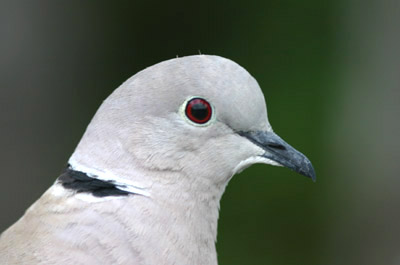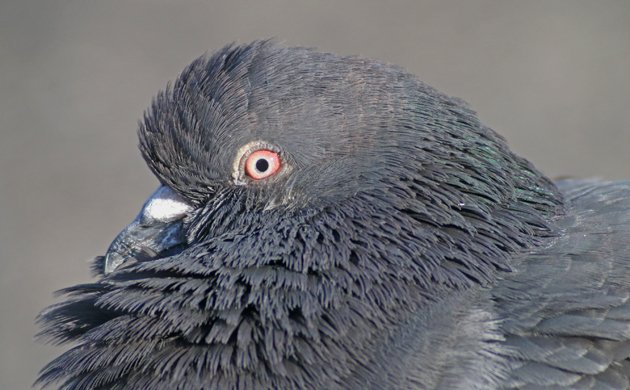Like most Northern Hemisphere birders, I’ve been monitoring the signs of spring like a dog watching the driveway for a beloved owner. My ears perk up with every new song, my tail wags (ok, not literally, but darn close) every time I see or hear about a newly-returned migrant. And reports of birds nesting – not owls, of course, those weirdo snow fetishists, but other birds nesting – light up my life.
So right now I’m feeling pretty good about Eurasian Collared-doves. With a hardiness that belies their delicate looks (but helps explain their phenomenal success), these pioneering pigeons are already sitting on eggs at at least one location in Montana.

A Eurasian Collared-dove photographed by Mike in the Bahamas, which is pretty different from midwinter Montana
Eurasian Collared-doves, as you may have gathered from the name, are not part of our native avifauna. Originally from India and the vicinity, it is believed that they had already undergone two major expansions – through Asia Minor in the 1600s, and then across Europe in the 1900s – when they first appeared in North America. The Collared-doves were introduced to the Bahamas in the 1970s, and from there apparently leapfrogged to the U.S. under their own steam (although other populations, escaped from captivity, may have joined up with the originals later.)
Most exotics, at least in the bird world, stick close to their point of arrival and barely hang on – or don’t – over the generations. It’s just that the exceptions are so much more attention-grabbing. We remember starlings not skylarks, House Sparrows not Eurasian Tree Sparrows, Cattle Egrets not… well, whatever we’ve forgotten because it didn’t do as well as the Cattle Egrets. The Eurasian Collared-Doves joined the illustrious (or notorious) few, and got firmly established in the Southeastern U.S., and if the story had stopped there it would be interesting enough.
But the story, and the birds, did not stop there. In 1998 W. M. Hochachka noted that one had spent the winter “as far north as eastern Montana”. The agricultural nature of the area seems to suit the Eurasian Collared Dove. Here – in a state so far removed from their native land that the entire city of Missoula doesn’t even have an Indian restaurant – they are now hunkered down amidst lingering snow to make more Eurasian Collared-doves. They appear regularly on our Christmas Bird Counts and number in the hundreds. Whatever they used to be, they are now a bird of Montana. And of Wyoming. And eventually, of who knows how many Western states?
Like any good ecologist, I couldn’t help but be suspicious when I first heard of this. “Invasive” is an ugly word, and ugly consequences have come from many of the explosive range expansions we’re most familiar with, whether of exotic species or even of native species with their normal restraints removed. A 2006 study found no evidence thus far that the Eurasian Collared-dove was out-aggressing Mourning Doves, though, and our other large native Columbiforme is gone through no fault of the new kid. The full impact of this particular expansion is still to be determined — in part because the full scope of the expansion is still to be determined — but provisionally the Eurasian Collared-Dove seems to be sitting with the Cattle Egret and the Monk Parakeet in the ranks of our better-behaved new birds. And after all, some birds have to expand their range sometimes.
So, tentatively, welcome spring and new life.




 New writers welcome – please contact us for details.
New writers welcome – please contact us for details.

















Still haven’t figured out why they haven’t stormed into the Northeast yet in any numbers, yet they have pushed well into central Canada. Maybe we have tough Mourning Doves in NY.
I’ve always like the Collared doves. Maybe because I don’t see so many of them.
Well written article with some facts I didn’t know.
Especially of all the species that had been introduced to the US.
Nice post, the Collared Doves also make it to South America. We have on here in Ecuador that is very prolific in the highlands.
@Will: I was curious about that myself. You’d think that the parks of New York City would be a natural for this bird, if it can survive from India to Montana.
@Nicole: Glad you liked it!
@Renato: Wow, these birds are truly cosmopolitan.
Ack!! Reading the title, I feared you had succumbed to the “hook & bullet” lifestyle of the Rockies and now carried a very, very big-calibered gun with you.
Glad that’s not the case.
I wonder if we’ll live to see the day when Collared Doves finish their world encirclement by expanding though Alaska into NE Asia and then linking up with the populations there (they have reached Japan and Korea).
The reason why they have expanded so rapidly in the Midwest and are still so rare in the NE might have climatic reasons. They are very common in Central Asia, which is very roughly comparable to the prairies. In Germany, they occur throughout but are considerably rarer e.g. around the Baltic or Berlin than they are in the SW. Maybe they are not so fond of coastal climates that get cold during the winter?
They arrived at my farm last summer (2010) in Southeast Idaho rear Rigby. Just one pair that nested in our Blue Spruce wind break. They returned again in early March (2011), only now a family of 10. They have replace a family of Mourning Doves that previously nested in the same trees and use the same close line pole to roost on during the day. Their call is certainly not as soothing as the Mourning Dove but so far they don’t seem to be trouble makers.
Im new to bird watching and have always been curious about doves i got some pictures of the morning dove but really want to see the eurasion dove. Any advice to where i might look for them around missoula. preferably not in town.
Thanks
I’m interested in finding out how hot it can be outside for a dove to surviv.